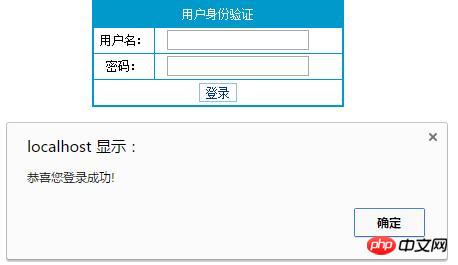Maison >développement back-end >tutoriel php >PHP utilise l'orientation objet pour implémenter la fonction d'authentification de connexion utilisateur
PHP utilise l'orientation objet pour implémenter la fonction d'authentification de connexion utilisateur
- 怪我咯original
- 2018-05-15 17:38:043867parcourir
Cet article présente principalement en détail l'authentification de connexion utilisateur orientée objet PHP. Il a une certaine valeur de référence. Les amis intéressés peuvent s'y référer
L'exemple dans cet article partage avec vous le code spécifique pour les utilisateurs PHP. l'authentification de connexion est pour votre référence. Le contenu spécifique est le suivant
1. Code
conn.php
<?php
$conn = new com("adodb.connection");
$connstr="driver={microsoft access driver (*.mdb)}; dbq=". realpath("data/db_database07_188.mdb");
$conn->open($connstr);
?>index. .php
<!DOCTYPE html PUBLIC "-//W3C//DTD XHTML 1.0 Transitional//EN" "http://www.w3.org/TR/xhtml1/DTD/xhtml1-transitional.dtd">
<html xmlns="http://www.w3.org/1999/xhtml">
<head>
<meta http-equiv="Content-Type" content="text/html; charset=gb2312" />
<title>用户身份验证</title>
<link rel="stylesheet" type="text/css" href="css/style.css" rel="external nofollow" >
<style type="text/css">
<!--
.STYLE1 {color: #FFFFFF}
-->
</style>
</head>
<body>
<table width="250" border="0" align="center" cellpadding="1" cellspacing="0">
<tr>
<td height="75" bgcolor="#0099CC"><table width="250" height="75" border="0" cellpadding="0" cellspacing="1">
<form name="form1" method="post" action="index.php">
<tr>
<td height="25" colspan="2" bgcolor="#0099CC"><p align="center" class="STYLE1">用户身份验证</p></td>
</tr>
<tr>
<td width="60" height="25" bgcolor="#FFFFFF"><p align="center">用户名:</p></td>
<td width="187" bgcolor="#FFFFFF"><p align="left"> <input type="text" name="username" size="22" class="inputcss"></p></td>
</tr>
<tr>
<td height="25" bgcolor="#FFFFFF"><p align="center">密码:</p></td>
<td height="25" bgcolor="#FFFFFF"><p align="left"> <input type="password" name="userpwd" size="22" class="inputcss"></p></td>
</tr>
<tr>
<td height="25" colspan="2" bgcolor="#FFFFFF"><p align="center"><input name="submit" type="submit" value="登录" class="buttoncss"></p></td>
</tr>
</form>
</table></td>
</tr>
</table>
<?php
if($_POST[submit]!="")
{
$username=$_POST[username]; //接收提交的用户名
$userpwd=$_POST[userpwd]; //接收提交的密码
if(trim($username)==""||trim($userpwd)=="")
{
echo "<script>alert('请输入用户名或用户密码!');history.back();</script>";
exit;
}
class chk //定义密码验证类
{
private $name; //定义用户名属性
private $pwd; //定义密码属性
public function __construct($x,$y) //构造函数,对类的属性初始化
{
$this->name=$x;
$this->pwd=$y;
}
public function chkuser() //验证用户身份
{
include_once("conn.php");
$rs=new com("adodb.recordset"); //创建记录集对象
$rs->open("select * from tb_user where username='".$this->name."' and userpwd='".$this->pwd."'",$conn,3,1);
if($rs->eof || $rs->bof)
{
echo "<script>alert('对不起,密码或用户名错误!');history.back();</script>";
exit;
}
else
{
echo "<script>alert('恭喜您登录成功!');history.back();</script>";
exit;
}
}
}
$chk1=new chk($username,$userpwd); //对密码验证类进行实例化
$chk1->chkuser(); //调用chkuser()方法验证用户身份
}
?>
</body>
</html>2.Résultats en cours

Ce qui précède est le contenu détaillé de. pour plus d'informations, suivez d'autres articles connexes sur le site Web de PHP en chinois!
Déclaration:
Le contenu de cet article est volontairement contribué par les internautes et les droits d'auteur appartiennent à l'auteur original. Ce site n'assume aucune responsabilité légale correspondante. Si vous trouvez un contenu suspecté de plagiat ou de contrefaçon, veuillez contacter admin@php.cn
Article précédent:Partagez un morceau de code fonctionnel pour php pour générer du code de vérification d'imageArticle suivant:Partagez un morceau de code fonctionnel pour php pour générer du code de vérification d'image
Articles Liés
Voir plus- Comment utiliser cURL pour implémenter les requêtes Get et Post en PHP
- Comment utiliser cURL pour implémenter les requêtes Get et Post en PHP
- Comment utiliser cURL pour implémenter les requêtes Get et Post en PHP
- Comment utiliser cURL pour implémenter les requêtes Get et Post en PHP
- Tous les symboles d'expression dans les expressions régulières (résumé)

